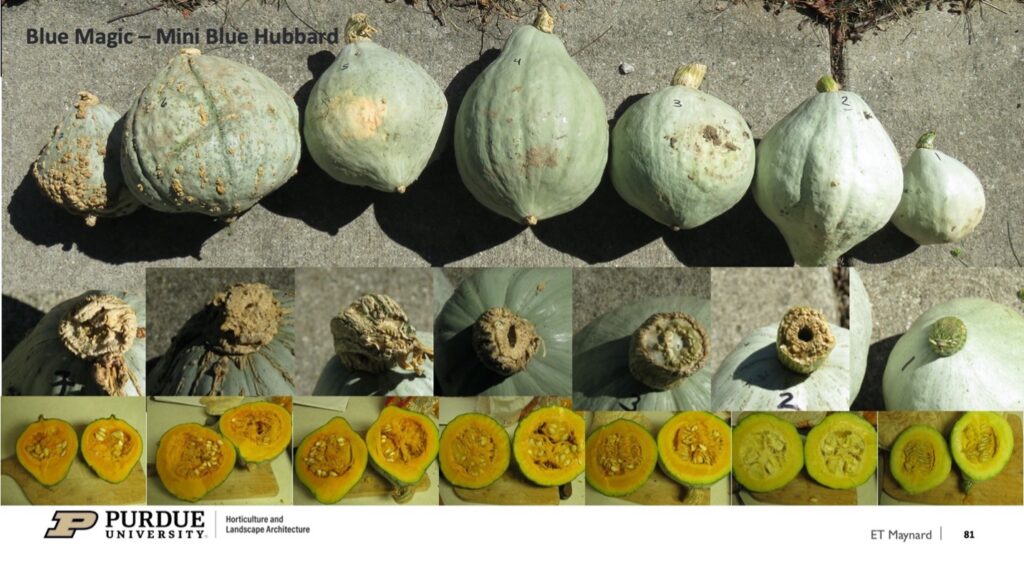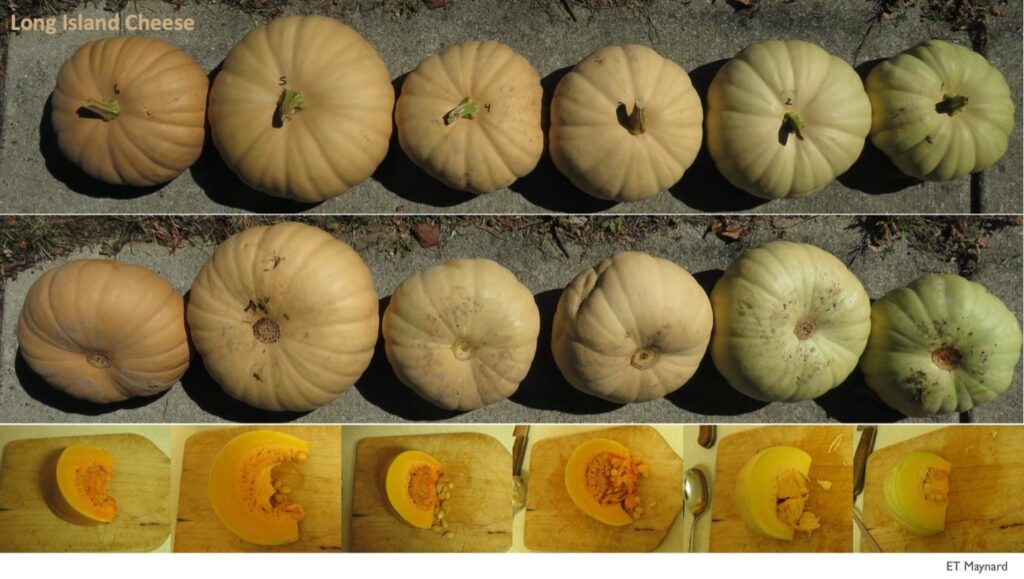As pumpkin season approaches, proper harvest timing and post-harvest handling become critical for maintaining fruit quality and maximizing storage life. Whether you’re growing Halloween jack-o’-lanterns or pie pumpkins for the holiday market, following best practices through harvest and storage will help ensure your season ends on a successful note.
Determining the Right Harvest Time
For Halloween Pumpkins: The challenge with Halloween pumpkins is balancing market timing with fruit quality. Since the pumpkin market typically runs from Labor Day through Halloween, fruit may need to be held for several weeks before sale. Key considerations include:
- Monitor vine condition carefully. Intact foliage protects fruit from sun damage, but when vines succumb to powdery or downy mildew, pumpkins become susceptible to sunscald
- Foliar diseases, particularly powdery mildew, can reduce handling quality, making jack-o’-lantern pumpkins less marketable
- As fall temperatures drop, prioritize avoiding chilling injury by harvesting before temperatures consistently fall below 50°F
For Pie Pumpkins and Winter Squash: Harvest timing directly affects flavor and texture. As fruits mature, they accumulate starch that converts to sugar both in the field and during storage. This balance of starch and sugar determines eating quality.
Squash and pumpkins reach maturity when seeds are completely filled, typically 50-55 days after fruit set. Harvesting immature fruit results in poor flesh quality, as the fruit uses starch reserves from the flesh to fill seeds, leaving insufficient starch for later sugar conversion. Chilling injury should be avoided by harvesting squash before the temperature falls consistently below 50°F.

Figure 1. Appearance of ‘Blue Magic,’ a miniature blue Hubbard winter squash, at varying stages of maturity (from right to left in picture). Top: whole fruit. Note darker rind color and corking on stem in more mature fruit (6 and 7, left) compared to immature fruit (1 and 2, right). Middle: close up of stem cross section. Bottom: cut fruit after cooking. Note darker orange flesh of more mature fruit (Photo by E.T. Maynard).

Figure 2. ‘Long Island Cheese’ winter squash at varying stages of maturity (from right to left in picture). Top: stem end of whole squash. Note darker rind color in more mature squash (6, left) compared to immature (1 and 2, right) and less mature squash (3, 4, and 5). Middle: blossom end of whole squash. Bottom: section of cut squash before cooking. Note darker orange flesh of more mature squash (Photo by E.T. Maynard).
Recognizing Maturity Indicators
Look for these signs that pumpkins and squash are ready for harvest:
- Loss of rind surface gloss.
- Skin hardening to resist thumbnail puncture.
- Solid external color development (except striped varieties).
- For many squash: ground spot yellowing (the area touching the soil should turn dark orange for acorn squash).
- For butternut squash: fruit turns tan, but wait an additional 2 weeks before harvesting. Fruit should turn a deep, uniform tan color.
- For buttercup, kabocha, and other C. maxima squash: stem has well-developed corking.
The Postharvest Research and Extension Center at UC Davis has an excellent publication featuring pictures that illustrate the maturity and internal quality of butternut and kabocha squash.
Proper Harvest Techniques
Despite their tough appearance, pumpkins and squash are easily damaged. Follow these handling guidelines:
- Use a sharp knife, pruning shears, or loppers to cut pumpkin and squash from vines.
- Leaving pumpkin stems long enough for an attractive product.
- If stems are removed from acorn types and butternut squash, allow scar to heal before storage.
- Handle fruit as little as possible and carry pumpkins like a ball, never by the stem.
- Use gloves to protect both the fruit and the workers.
- Brush off soil that adheres to the pumpkin or squash.
- Place fruit gently in containers and move bins on pallets to prevent damage.
- Watch for sharp edges that could puncture rinds during transport and storage.
Washing and Sanitizing
If washing pumpkins or squash:
- Include a labeled sanitizer in wash water
- Thoroughly dry pumpkins before storage
- Ensure all equipment is clean to prevent contamination
Curing for Quality Enhancement
Curing benefits most varieties, especially when the fruit shows non-hardened skin or surface damage. Proper curing:
- Heals wounds and hardens the rind
- Enhances fruit color and increases sugar content
- Should be conducted at 80-85°F in a shaded, well-ventilated area for 5-10 days
- Can take place in the field if night temperatures stay above 60°F, or in barns, greenhouses, or high tunnels
Important note: Do not cure acorn (or other C. pepo) squash as it accelerates skin color change, deteriorates texture and taste, and stimulates fruit decay.
Optimal Storage Conditions
Create the best possible storage environment with these parameters:
Temperature: 50-55°F (chilling injury possible below 50°F; storage life reduced above 60°F)
Humidity: 50-70% relative humidity
Ventilation: Well-ventilated, dry location
Protection: Keep fruit off the ground using pallets or similar materials
Storage Life Expectations
Under optimal conditions, expect these storage periods:
- Acorn squash: 2-3 months
- Pumpkins: 2-3 months
- Butternut squash: 3-4 months
- Hubbard, kabocha, and buttercup squash: 4-6 months
Common Storage Mistakes to Avoid
- Ethylene exposure: Keep pumpkins away from apples, ripening tomatoes, and cantaloupes.
- Temperature fluctuations: Large temperature swings encourage condensation and fruit rot.
- Stacking: Avoid stacking pumpkins to reduce pressure damage.
- Ground contact: Always keep fruit elevated off floor or ground.
- Frost exposure: Protect from temperatures below 45°F with tarps or move to protected areas.
Field Holding Considerations
If pumpkins must remain in the field for pick-your-own operations:
- Scout carefully for diseases and insects.
- Apply protectant fungicides combined with targeted powdery mildew products (consult the Midwest Veg Guide).
- Monitor for squash bug nymphs, adults, and striped cucumber beetles.
- Consider that fruit exposed to chilling temperatures will not store well and should be marketed first.
Best Practices for Your Team
Train all farm personnel handling pumpkins on proper techniques. Remember that once the rind is bruised or punctured, decay organisms quickly invade and break down the fruit. Consistent, careful handling throughout the harvest and storage process is essential for maintaining the high-quality pumpkins your customers expect.
Even if ideal storage conditions aren’t possible, storing pumpkins in a shady, dry location with the fruit elevated off the ground is far preferable to leaving them in the field. With attention to these harvest and post-harvest details, you can maximize both the quality and profitability of your pumpkin crop.
Literature Sources
Egel, D. and W. Guan. 2022. Tips for Harvest and Postharvest of Pumpkin and Winter Squash. Vegetable Crops Hotline, Issue 712. https://vegcropshotline.org/article/tips-for-harvest-and-postharvest-of-pumpkin-and-winter-squashes/
Hazzard, R. 2015. Pumpkin and winter squash harvest and storage. Vegetable Grower News. https://vegetablegrowersnews.com/news/pumpkin-and-winter-squash-harvest-and-storage/
Maynard, L. 2015. Harvest and Post-harvest Care for High Quality Pumpkins. Vegetable Crops Hotline, Issue 606. https://vegcropshotline.org/article/harvest-and-post-harvest-care-for-high-quality-pumpkins/
Pumpkin & Winter Squash. UC Davis Postharvest Research and Extension Center. Retrieved on September 4, 2025. https://postharvest.ucdavis.edu/produce-facts-sheets/pumpkin-winter-squash
UMass Extension. 2025. Pumpkin & Winter Squash Harvest, Curing & Storage. Vegetable Notes, Vol. 37:20. https://www.umass.edu/agriculture-food-environment/vegetable/newsletters/vegetable-notes/vegetable-notes-2025-vol-3720#a3